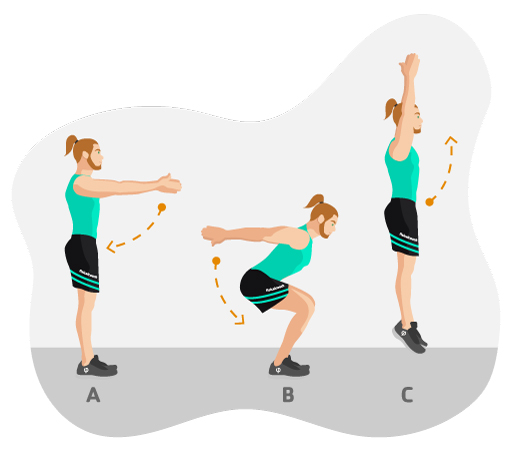
Abalakov jump (ABK)
The main purpose of the Abalakov jumping test (ABK) is to measure the explosive strength and maximal power of the lower limbs. It was named after the scientist who first described it in 1938. The ABK test is part of the Bosco vertical jump test battery to assess the functional, neuromuscular and morphophysiological characteristics of the extensor muscles of the lower limbs. The type of muscular action developed in this test is concentric contraction preceded by a very brief phase of eccentric contraction.
- Required Material: Different measuring instruments can be used, such as: force platforms, contact platforms, optical position transducers (infrared), accelerometers, video analysis or even specific software and apps.
- Procedure: The subject starts this test in an upright position and has to perform a vertical jump after a rapid downward countermovement. A vertical jump is performed by means of a stretch-shortening cycle (SSS), i.e. a flexion followed as quickly as possible by an extension of the legs with free influence of the arms. The subject must bend his/her knees to an angle of 90 degrees. It is very similar to the Countermovement Jump (CMJ), except that in this test the arms can be used to benefit the vertical jump. As can be seen in the picture, the arms are moved backwards and then pushed vigorously forwards and upwards during the jump. The reachable height can be affected by the angle the subject bents his/her legs, so the test may be invalidated if he/she does not bend the legs the required 90 degrees.
- Assessment: The height of the jump must be measured in centimetres (cm) and the subject has a maximum of 3 attempts. In Fisicalcoach, the highest height reached by the subject can be recorded, as well as the mean and the median. In addition to jump height, different variables of interest depending on the measuring instrument can be recorded.
- Remarks: The Abalakov vertical jump test depends on many interrelated factors that make it very difficult to analyse. Even so, many researchers conclude that the most important thing is good execution technique and good training, in addition to the individual characteristics of peak explosive strength, power and joint torque.
Take this test and 139 more in our App